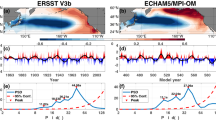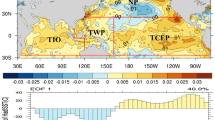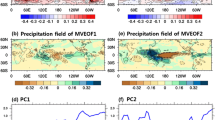Abstract
The Pacific Walker circulation (PWC) is one of the major atmospheric circulations that plays an essential role in ocean-atmosphere interactions and global climate. The response of the PWC to greenhouse warming remains a mystery and model results are inconsistent. Based on multimodel simulations from the Coupled Model Intercomparison Project phase 6 (CMIP6), this study explores the intermodel uncertainty of the change in the PWC under global warming. The combination of the El Niño-like warming pattern and the interbasin warming contrast between the Indian and Pacific Oceans strengthens (weakens) the west (east) branch of the Pacific trade winds, resulting in a structural shifting of the PWC. By conducting a set of Atmosphere General Circulation Model (AGCM) experiments, we demonstrate that the western Pacific warming plays a critical role in driving the PWC shift. An intensified western Pacific warming counteracts the effect of Indian Ocean warming on the PWC, leading to a uniformly weakened PWC in the tropical Pacific due to the SST gradient. In contrast, a decreased warming in the western Pacific strengthens the west branch of the PWC, shifting the turning longitude of zonal wind changes eastward. Our finding highlights that the relative warming pattern in the Indian and Pacific Oceans is coupled with the PWC change in a warmer climate.














Similar content being viewed by others
Data availability
The CMIP6 outputs are obtained from https://esgf-node.llnl.gov/search/cmip6/. The ERSST v5 dataset is downloaded from http://psl.noaa.gov/data/gridded/data.noaa.ersst.v5.html. The HadISST dataset is downloaded from https://www.metoffice.gov.uk/hadobs/hadisst/. The GPCP data is available from https://psl.noaa.gov/data/gridded/data.gpcp.html.
References
Adler RF et al (2003) The Version2 global precipitation Climatology Project (GPCP) Monthly Precipitation Analysis (1979 Present). J Hydrometeorol 4:1147–1167
Brient F (2020) Reducing Uncertaintues in Climate Projections with Emergent Constraints: concepts, examples and prospects. Adv Atmos Sci 37(1):1–15
Cai W et al (2019) Pantropical climate interactions. Science 363(6430):1–11
Chung E-S, Timmermann A, Soden BJ, Ha KJ, Shi L, John VO (2019) Reconciling opposing Walker circulation trends in observations and model projections. Nat Clim Change 9:405–412
Clement AC, Seager R, Cane MA, Zebiak SE (1996) An Ocean Dynamical Thermostat. J Clim 9:2190–2196
Cox PM, Huntingford C, Williamson MS (2018) Emergent constraint on equilibrium climate sensitivity from global temperature variability. Nature 553:319–322
DiNezio PN, Vecchi GA, Clement AC (2013) Detectability of changes in the Walker circulation in response to global warming. J Clim 26:4038–4048
Dong BW, Lu RY (2013) Interdecadal enhancement of the Walker circulation over the Tropical Pacific in the late 1990s. Adv Atmos Sci 30:247–262
Dong L, Zhou T, Chen X (2014) Changes of Pacifiic decadal variability in the twentieth century driven by internal variability, greenhouse gases, and aerosols. Geophys Res Lett 41:8570–8577
England MH et al (2014) Recent intensification of wind-driven circulation in the Pacific and the ongoing warming hiatus. Nat Clim Change 4:222–227
Feng M, Böning C, Biastoch A, Behrens E, Weller E, Masumoto Y (2011) The reversal of the multi-decadal trends of the equatorial Pacific easterly winds, and the indonesian throughflow and Leeuwin Current transports. Geophys Res Lett 38:1–6
Hall A, Cox P, Huntingford C, Klein S (2019) Progressing emergent constraints on future climate change. Nat Clim Change 9:269–278
Han W et al (2013) Intensification of decadal and multi-decadal sea level variability in the western tropical Pacific during recent decades. Clim Dyn 43:1357–1379
He C, Cui Z, Wang C (2022) Response of western North Pacific Anomalous Anticyclones in the summer of decaying El Niño to global warming: diverse projections based on CMIP6 and CMIP5 models. J Clim 35(1):359–372
Heede UK, Fedorov AV (2021) Eastern equatorial pacific warming delayed by aerosols and thermostat response to CO2 increase. Nat Clim Change 11:696–703
Heede UK, Fedorov AV, Burls NJ (2020) Time Scales and Mechanisms for the Tropical Pacific response to global warming: a tug of War between the Ocean Thermostat and Weaker Walker. J Clim 33:6101–6118
Held IM, Soden BJ (2006) Robust responses of the hydrological cycle to global warming. J Clim 19:5686–5699
Henley BJ, Gergis J, Karoly DJ, Power S, Kennedy J, Folland CK (2015) A Tripole Index for the Interdecadal Pacific Osscillation. Clim Dyn 45:3077–3090
Hu S, Fedorov AV (2019) Indian Ocean warming can strengthen the Atlantic meridional overturning circulation. Nat Clim Change 9:747–751
Huang B, Thorne PW, Banzon VF, Boyer T, Zhang HM (2017) Extended reconstructed Sea Surface temperature, Version 5 (ERSSTv5): upgrades, validations, and Intercomparisons. J Clim 30:8179–8205
Huang P, Ying J (2015) A Multimodel Ensemble Pattern regression method to correct the Tropical Pacific SST change patterns under global warming. J Clim 28:4706–4723
Johnson NC, Xie S-P (2010) Changes in the sea surface temperature threshold for tropical convection. Nat Geosci 3(12):842–845
Kang SM et al (2020) Walker circulation response to extratropical radiative forcing. Sci Adv 6:eabd3021
Karnauskas KB, Seager R, Kaplan A, Kushnir Y, Cane MA (2009) Observed strengthening of the Zonal Sea Surface temperature gradient across the Equatorial Pacific Ocean. J Clim 22:4316–4321
Knutson TR, Manabe S (1995) Time-Mean response over the Tropical Pacific to increased C02in a coupled ocean-atmosphere Model. J Clim 8:2181–2199
Li G, Xie S-P (2014) Tropical biases in CMIP5 Multimodel Ensemble: the excessive Equatorial Pacific Cold Tongue and double ITCZ problems. J Clim 27:1765–1780
Li G, Xie S-P, Du Y, Luo Y (2016) Effects of excessive equatorial cold tongue bias on the projections of tropical Pacific climate change. Part I: the warming pattern in CMIP5 multi-model ensemble. Clim Dyn 47:3817–3831
Li G, Xie SP, He C, Chen Z (2017) Western Pacific emergent constraint lowers projected increase in indian summer monsoon rainfall. Nat Clim Change 7:708–712
Luo J-J, Sasaki W, Masumoto Y (2012) Indian Ocean warming modulates Pacific climate change. Proc Natl Acad Sci 109:18701–18706
Luo Y, Lu J, Liu F, Garuba O (2017) The role of ocean dynamical thermostat in delaying the El Niño-like response over the equatorial Pacific to climate warming. J Clim 30:2811–2827
Ma J, Xie S-P, Kosaka Y (2012) Mechanisms for tropical tropospheric circulation change in response to global warming. J Clim 25(8):2979–2994
Marx L, Misra V, Brunke M, Zeng X (2008) The Equatorial Pacific Cold Tongue Bias in a coupled climate model. J Clim 21:5852–5869
McGregor S, Timmermann A, Stuecker MF, England MH, Merrifield M, Jin F-F, Chikamoto Y (2014) Recent Walker circulation strengthening and Pacific cooling amplified by Atlantic warming. Nat Clim Change 4:888–892
Mechoso CR et al (1995) The Seasonal cycle over the Tropical Pacific in coupled ocean-atmosphere general circulation models. Mon Weather Rev 123:2825–2838
Meng Q, Latif M, Park W, Keenlyside NS, Semenov VA, Martin T (2011) Twentieth century Walker circulation change: data analysis and model experiments. Clim Dyn 38:1757–1773
Power SB, Kociuba G (2015) Inability of CMIP5 models to simulate recent strengthening of the Walker circulation: implications for projections. J Clim 28:20–35
Ramanathan V, Collins W (1991) Thermodynamic regulation of ocean warming by cirrus clouds deduced from observations of the 1987 El Niño. Nature 351:27–32
Rayner NA (2003) Global analyses of sea surface temperature, sea ice, and night marine air temperature since the late nineteenth century. J Geophys Res 108:4407
Seager R, Cane MA, Henderson N, Lee D-E, Abernathey R, Zhang H (2019) Strengthening tropical Pacific zonal sea surface temperature gradient consistent with rising greenhouse gases. Nat Clim Change 9:517–522
Sohn B-J, Lee S, Chung E-S, Song H-J (2016) The role of the Dry Static Stability for the recent change in the Pacific Walker circulation. J Clim 29(8):2765–2779
Sohn B-J, Yeh S-W, Lee A, Lau WKM (2019) Regulation of atmospheric circulation controlling the tropical Pacific precipitation change in response to CO2 increases. Nat Commun 10:1108
Takahashi K, Montecinos A, Goubanova K, Dewitte B (2011) ENSO regimes: reinterpreting the canonical and Modoki El Niño. Geophys Res Lett 38:L10704
Tokinaga H, Xie S-P, Deser C, Kosaka Y, Okumura YM (2012) Slowdown of the Walker circulation driven by tropical indo-pacific warming. Nature 491:439–443
Vecchi GA, Soden BJ (2007) Global warming and the weakening of the Tropical circulation. J Clim 20:4316–4340
Vecchi GA, Clement A, Soden BJ (2008) Examining the Tropical Pacific’s response to global warming. Eos Trans Am Geophys Union 89:81–83
Wang C, Zhang L, Lee S-K, Wu L, Mechoso CR (2014) A global perspective on CMIP5 climate model biases. Nat Clim Change 4:201–205
Wang C (2019) Three-ocean interactions and climate variability: a review and perspective. Clim Dyn 53:5119–5136
Wang X-Y et al (2021) Underestimated responses of Walker circulation to ENSO-related SST anomaly in atmospheric and coupled models. Geosci Lett 8(1):1–13
Williams AP, Funk C (2011) A westward extension of the warm pool leads to a westward extension of the Walker circulation, drying eastern Africa. Clim Dyn 37:2417–2435
Wu M et al (2021) A very likely weakening of Pacific Walker circulation in constrained near-future projections. Nat Commun 12:6502
Xie S-P, Wittenberg AT, Teng H, Ma J, Vecchi GA, Deser C (2010) Global warming pattern formation: Sea Surface temperature and rainfall. J Clim 23:966–986
Yim BY, Yeh S-W, Song H-J, Dommenget D, Sohn BJ (2017) Land-sea thermal contrast determines the trend of Walker circulation simulated in atmospheric general circulation models. Geophys Res Lett 44:5854–5862
Ying J, Huang P, Lian T, Tan H (2018) Understanding the effect of an excessive cold tongue bias on projecting the tropical Pacific SST warming pattern in CMIP5 models. Clim Dyn 52:1805–1818
Ying J, Collins M, Cai W, Timmermann A, Huang P, Chen D, Stein K (2022) Emergence of climate change in the tropical Pacific. Nat Clim Change 12:356–364
Zebiak SE, Cane MA (1987) A model El Niño-Southern Oscillation. Mon Weather Rev 115:2262–2278
Zhang L, Li T (2016) Relative roles of differential SST warming, uniform SST warming and land surface warming in determining the Walker circulation changes under global warming. Clim Dyn 48:987–997
Zhang L, Karnauskas KB (2017) The role of Tropical Interbasin SST gradients in forcing Walker circulation Trends. J Clim 30:499–508
Zhang L, Han W, Karnauskas KB, Meehl GA, Hu A, Rosenbloom N, Shinoda T (2019) Indian ocean warming Trend reduces pacific warming response to anthropogenic greenhouse gases: an interbasin thermostat mechanism. Geophys Res Lett 46:10882–10890
Zhang L et al (2021) Pacific warming pattern diversity modulated by Indo-Pacific Sea Surface temperature gradient.Geophys Res Lett48: e2021GL095516
Zheng X-T, Xie S-P, Vecchi GA, Liu Q, Hafner J (2010) Indian Ocean Dipole response to global warming: analysis of Ocean–Atmospheric Feedbacks in a coupled model. J Clim 23:1240–1253
Zheng X-T, Xie S-P, Du Y, Liu L, Huang G, Liu Q (2013) Indian Ocean Dipole response to global warming in the CMIP5 Multimodel Ensemble. J Clim 26:6067–6080
Zheng Y, Lin J-L, Shinoda T (2012) The equatorial Pacific cold tongue simulated by IPCC AR4 coupled GCMs: Upper ocean heat budget and feedback analysis. J Geophys Res 117:C05024
Acknowledgements
This work is supported by the National Key R&D Program of China (2018YFA0605704), the National Natural Science Foundation of China (41975092, 42230405) and Shandong Natural Science Foundation Project (ZR2019ZD12). We are grateful for the freely available data used in this paper. The CMIP6 outputs are obtained from https://esgf-node.llnl.gov/search/cmip6/. The ERSST v5 dataset is downloaded from http://psl.noaa.gov/data/gridded/data.noaa.ersst.v5.html. The HadISST dataset is downloaded from https://www.metoffice.gov.uk/hadobs/hadisst/. The GPCP data is available from https://psl.noaa.gov/data/gridded/data.gpcp.html.
Funding
This work is supported by the National Key R&D Program of China (2018YFA0605704), the National Natural Science Foundation of China (41975092, 42230405) and Shandong Natural Science Foundation Project (ZR2019ZD12).
Author information
Authors and Affiliations
Contributions
Zi-Wen Han conducted the analysis and model experiments of this study under the guidance of Xiao-Tong Zheng. The first draft of the manuscript was written by Zi-Wen Han and revised by Xiao-Tong Zheng. Both authors read and approved the final manuscript.
Corresponding author
Ethics declarations
Ethics approval and consent to participate
Not applicable.
Consent for publication
Not applicable.
Competing interests
The authors have no relevant financial or non-financial interests to disclose.
Additional information
Publisher’s note
Springer Nature remains neutral with regard to jurisdictional claims in published maps and institutional affiliations.
Appendices
Appendix A
Design of the CAM5 experiments.
Previous studies have demonstrated that the enhanced tropical Indian Ocean warming plays an important role in modulating the Pacific trade winds (Luo et al. 2012; Zhang et al. 2019). We firstly conduct two experiments to verify the effect of Indian Ocean warming on the PWC. In addition to the control run (CTRL), which is forced by the observed monthly climatological SST and sea ice concentration, an experiment named WARMIO impose 1-K warming in the tropical Indian Ocean (25°S-25°N, 30°E-130°E) to mimic the Indian Ocean warming (Fig. 14a). As a cosine function, the imposed warming is largest in the center of the basin (80°E, equator) and gradually decreases in the surrounding areas.
Most CMIP6 models project an El Niño-like warming over the Pacific Ocean. To investigate the combined effect of the Indian Ocean warming and the El Niño-like warming on the PWC, we then design another series of experiments, imposing both 1-K Indian Ocean warming and 2-K equatorial Pacific (5°S-5°N, 130°E-90°W) warming. The imposed warming is largest in the eastern Pacific cold tongue (100°W, equator) and gradually decreases westward as a sine function. Considering the large intermodel diversity of the western Pacific warming, we set three different drop rates to simulate the various patterns of the SST warming in the tropical Pacific, with the imposed warming decreasing to 0 K, 0.5 K, and 1 K at 160°E, named WP0K, WP0.5 K, and WP1K, respectively (Fig. 14b, c, d). The SST warming is constant throughout the year. Each experiment runs for 30 years. The climatological mean of the last 20-year of each experiment is analyzed.
Appendix B
Correction method for the Pacific trade winds projections.
The 36-year (1979–2014) mean precipitation with the IPO signal linearly removed in the eWCP (2.5°S-2.5°N, 140°E-170°W) from CMIP6 historical simulation and GPCP dataset are called \(P\left(m\right)\) and \(P\left(obs\right)\), respectively. The IPO signal is represented by the IPO tripole index (TPI, Henley et al. 2015) in this study. The model bias of eWCP precipitation is calculated as:
where obs and m donate observation and individual model, respectively.
By conducting a linear regression analysis, we get the regression patterns “\(a\left(s\right)\)” and “\(b\left(s\right)\)” which express the present-future relationship between the climatologically mean eWCP precipitation “\(P\left(m\right)\)” and the surface zonal winds change “\(C(s,m)\)” in CMIP6 models:
where s denotes space (longitude \(\times\) latitude).
Given the significant correlation between present simulations and future projections, the error changes in surface zonal winds “\({C}^{{\prime }}\left(s,m\right)\)” of an individual model can be estimated by the regression coefficient “\(a\left(s\right)\)” and the precipitation bias “\({\text{P}}^{{\prime }}\left(m\right)\)”, which represent the magnitudes of the present-future relationship and the bias, respectively.
Then we get the corrected result for each model:
Rights and permissions
Springer Nature or its licensor (e.g. a society or other partner) holds exclusive rights to this article under a publishing agreement with the author(s) or other rightsholder(s); author self-archiving of the accepted manuscript version of this article is solely governed by the terms of such publishing agreement and applicable law.
About this article
Cite this article
Han, ZW., Zheng, XT. Intermodel uncertainty in response of the Pacific Walker circulation to global warming. Clim Dyn 61, 2317–2337 (2023). https://doi.org/10.1007/s00382-023-06685-y
Received:
Accepted:
Published:
Issue Date:
DOI: https://doi.org/10.1007/s00382-023-06685-y




